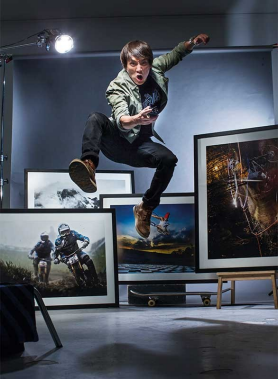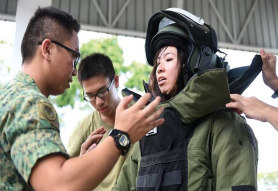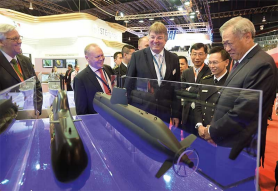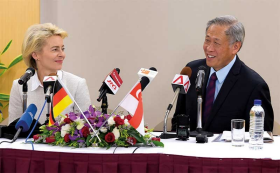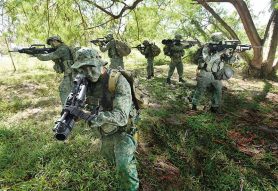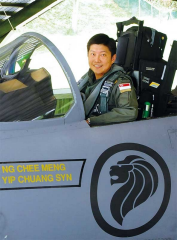They came from all walks of life to join the Singapore Armed Forces (SAF) during its formative years. These SAF pioneers share their stories.
Most would know the tale of how Singapore's defence in 1965 started with two infantry battalions of 50 officers and about 1,000 men for the Army, and two ships for the Navy. There was no air force.
From there, the Ministry of the Interior and Defence (pre-cursor to the present-day Ministry of Defence) started to build up the SAF. In 1967, National Service was started.
The Army had the 1st and 2nd Battalions, Singapore Infantry Regiment (1 SIR and 2 SIR). These were bolstered by the Singapore Volunteer Corps and Vigilante Corps to protect sites of strategic importance.
The Republic of Singapore Navy (RSN), with its roots in the Singapore Naval Volunteer Force (SNVF), started off with three ships. Of the three, only two were seaworthy.
In 1968, the Singapore Air Defence Command (SADC) was formed. It used Cessna 172 aircraft to train its pilots for Singapore's first fighter aircraft - the Hawker Hunters - which were added to the fleet in 1970. Five years later, the SADC became the Republic of Singapore Air Force (RSAF).
These hodge-podge beginnings carried a generation of men and women who came together and built the defence of Singapore.
Here are their personal stories as they recount the early years.
First NSF turned Regular
LTC (Ret) Albel Singh, 66
Barely 20 years old, Lieutenant Colonel (LTC) (Ret) Singh found himself entrenched off Changi Coast with his rifle and the rest of his platoon mates.
Live rounds at the ready, he was deployed there over the period that two Indonesian insurgents were to be executed for setting off a bomb in downtown Singapore. "The whole battalion was there. My company looked after a sector about 700m long," said LTC (Ret) Singh.
"When dawn broke, we saw all these Indonesian ships off the coast from our entrenchments... Thankfully nothing happened. We had our show of force and they had theirs."
That was in October 1968, when he was a Corporal fresh out of Section Leaders Course. "I remember looking at my rifle and wondering if I was actually able to lead my men properly. There was both a sense of apprehension and excitement."
A year later, he was deployed again. This time, it was the race riots, and his company was sent to maintain the peace in the Tai Seng area.
Those two episodes made him realise the importance of national defence, and led him to join the SAF as a Regular in 1970. "We need to commit our time and effort to be part of the country s defence because we can t leave it to anyone else."
During his time in the SAF, LTC (Ret) Singh also served with the Singapore Combat Engineers. "We did almost everything manually in those days, building our bridges."
It was back-breaking work, hauling heavy military bridge parts by hand. "You learnt to depend on your buddy. Teamwork made everything possible," said LTC (Ret) Singh.
He retired from the SAF in 1999. His last appointment was Commander of the 29th Singapore Infantry Brigade.
"In hindsight, I m proud of my generation's part in building up the SAF and our role in shaping the country."
Pioneering spirit
MAJ (Ret) Azib Bin Shaik Din, 83
Originally from Penang, Malaysia, Major (MAJ) (Ret) Azib left for Singapore and joined the harbour board police force. "It was the only English-speaking unit in the Police and I was English-educated."
In 1966, he was seconded to the SAF to help train the first few batches of soldiers for Singapore. He remembers the first trainees: "They were not very educated but good, tough soldiers and they took to physical training like crazy."
He was also part of the core group that started the 5 SIR. "I remember going around in our GP (General Purpose) car, gathering the equipment we needed to start the unit."
He did the same for the 3rd Singapore Infantry Brigade, housed in the now-defunct Ulu Pandan Camp. The site is now a hostel for tertiary students. "I spent most of my time helping to set up new units; I think it was because I had the experience from being both in the Police and Army."
MAJ (Ret) Azib looks back at his time with a matter-of-fact frankness. "All this celebration of pioneers; people of my generation are not used to this - we just did what we needed to do and to survive."
She's got (man)power
SWO (Ret) Mary Lim Siew Kheng, 62
In October 1970, Senior Warrant Officer (SWO) (Ret) Lim joined the SAF as a clerk. "The pay was $90 a month. It was not much but enough."
Her office was at Dempsey Road where she rose to become Chief Clerical Supervisor at the Career Plans Centre, holding the rank of 3rd Sergeant.
She was then posted to an operational unit - 3 SIR - in 1984. "I saw how a unit functioned, taking in recruits and training them to become soldiers and forming the Battalion.
"It was eye-opening because I saw how my manpower role helped these soldiers to concentrate on their jobs."
Her last posting to the 9th Army Maintenance Base as the unit's Manpower Officer gave her perspective of another side of the SAF.
"The unit maintains SAF vehicles for the combatants. Usually after major exercises, the fighting units sent their vehicles to us for maintenance.
"The job was very intense and the vehicle turnaround was very fast; the technicians would often work late into night to get the vehicles ready."
Looking at her 37 years in the SAF, SWO (Ret) Lim said: "I started as a junior clerk, sotong sotong (blur blur), and wrapped up my career as a manpower officer. It was very satisfying."
War Stories
SWO (Ret) Wee Cheng Leong, 77
Back when he started with the navy, the RSN was not even formed yet. As a young man, SWO (Ret) Wee signed up as a junior sailor with the Royal Malaysian Naval Volunteer Reserve in 1956.
"We went for training every Tuesday and Friday evening and we were paid $2.50 each time," said SWO (Ret) Wee. From 1963 to 1965, he was mobilised during Konfrontasi when Indonesia opposed the formation of Malaysia (which Singapore was then part of).
He remembers the tense moments patrolling the waters along Telok Ayer Basin to stop Indonesian insurgents from infiltrating Singapore. "We were part of many other volunteers who were mobilised during the episode."
"Some of us were hurt but we carried on, we had a mission (to fulfil)," said SWO (Ret) Wee. When Singapore gained independence, SWO (Ret) Wee quit his job at a department store to join the SNVF. In 1969, he became a Regular and stayed till 1995.
"We started with two small ships, RSS Panglima and RSS Bedok, and everything was done manually," said SWO (Ret) Wee, who remembers having to scrub the decks by hand on the 33m-long ship. Today, the RSN operates 141m-long Landing Ships Tank (LSTs), technologically advanced stealth frigates and even submarines.
"All in all, I never regretted joining the Navy. During my time, we had to be rough-and-tough; we were not as tech-savvy as today's generation.
"But what we had was the readiness to do necessary things to build the navy up."
The boatman
SSG (Ret) Baldev Singh, 64
When Staff Sergeant (SSG) (Ret) Singh recently visited the modern LST RSS Endurance, he could not recognise the ship.
"I was fascinated when I saw it. Helicopters on board and all that, it was great!" said SSG (Ret) Singh, who had been part of the crew who escorted RSS Endurance's predecessor into Singapore in 1975.
A warship of the same name that was bought from the United States Navy in the 1970s precedes the current RSS Endurance.
SSG (Ret) Singh has sailed on board an even older ship, RSS Cairnhill, which was sold to Singapore when the British pulled out.
"It was a landing craft, like the Endurance which we escorted. Back then, I thought that Endurance was big. That was until I saw the modern-day one!"
The boat-trained SSG (Ret) Singh joined the SAF in 1970. "My family didn t know I had signed on as a Regular but I loved the life."
The boat unit was part of the RSN for a few years. Part of their work was to patrol the waters off the live-firing areas in western Singapore and the outlying islands.
"In those days, people would wander into those areas by boat and try to pick the fruits which grew wild there," explained SSG (Ret) Singh.
"Obviously, it was dangerous for them to be there when the SAF was conducting live-firing exercises!"
He stayed in the SAF for 26 years, rising to become a Senior Instructor in the Boat Company and eventually finished his career at SAFTI Military Institute.
He recalls seeing the RSN s fast boats at a recent National Day Parade (NDP). "I was so amazed at the boats we have now, so powerful and fierce. I would have loved to be on them!"
Air medic
SWO (Ret) Johnny Lim Kok Teong, 60
Younger Singaporeans know the Dempsey Hill area as a place filled with chic restaurants. For SWO (Ret) Lim, it is where he started in the SAF Medical Corps.
The SAF Medical Corps began in 1967. "We were quite limited in equipment and had to use whatever the British left behind," said SWO (Ret) Lim. Slowly, more medical technologies were brought into the SAF in the 1980s.
"In the 90s, we began looking overseas for better training opportunities," said SWO (Ret) Lim, who was trained as an RSAF medic. The SAF started sending senior medics to Canada to pick up advanced paramedic skills in 1996.
In the early 2000s, the SAF Medical Corps moved to Nee Soon Camp. The new building meant that training and Headquarters administration were now housed under one roof.
Today, the SAF Medical Corps uses highly realistic patient simulators to teach medics how to tend to severe trauma wounds and other injuries. "Though technology was not so advanced back then, we did think of how to further the Corps," said SWO (Ret) Lim, who retired in 2006 as Regimental Sergeant Major of the SAF Medical Corps. "Now it's up to the younger generation to go even further."
Good vibes
MAJ (Ret) Ervin Edmund Dragon, 74
He has provided the music for much of Singapore's moments, both happy and sad. "I played for graduation parades, NDP and even state funerals."
MAJ (Ret) Dragon s road to the SAF started with the Police. He joined the Police Band in 1960 and stayed for nine years. A Colombo Plan scholar, he was seconded to the SAF after returning from his studies in music.
Stationed at the now-defunct Beach Road Camp for about two years, the band moved to Selarang Camp in 1972. "When we moved, we practised so much that people complained about the noise!"
In the early days, the SAF had a few bands all serving their respective units. The band led by MAJ (Ret) Dragon was called the Band of the Singapore Armoured Regiment, which relocated to Tengah Air Base in 1982 after being renamed RSAF Band.
He always took special pride in the turnout of his band. "I would make sure the uniforms fitted properly and they were all the same shade of white... You could see the difference that pride made when my band marched out."
MAJ (Ret) Dragon and his band provided musical accompaniment for the fledgling SAF then. "The SAF has progressed so much because of its people. I remember that our leaders demanded a lot from us, and we too wanted to show our best."
First of the fighters
LTC (Ret) Timothy De Souza, 68
In his time, LTC (Ret) De Souza sang three different national anthems. As a child, he sang God save the Queen as a British subject. As a young adult, he sang the Malaysian anthem before Singapore s independence. Today, he sings the Majulah Singapura.
He has another unique experience he was also one of the first Singaporean fighter pilots. Trained in the United Kingdom (UK) for two years, he returned in 1970 to fly the refurbished Hawker Hunters in 140 Squadron (SQN) where he also flew as one of Singapore's first Black Knights (then known as the Osprey Reds).
"That was the most fantastic flying of my life. We had fast, complicated aircraft and there was a certain amount of risk involved.
"But for fighter pilots, this was it. We lived by our skill and courage, always pushing ourselves for a better performance. Taking care of each other was also part of the mission. There were no prizes for coming back dead, all smashed up on a mountain side!"
After five years of flying, he went on to become an instructor in 1975 and rose to command the RSAF's Flying Training School by 1982. "During my time, we expanded the intake four times," he said.
The reason? Singapore needed more skilled pilots to operate the fighter aircraft that were coming.
"We were pushing out pilots as the technical people worked to refurbish planes that Singapore had bought to start the air force," explained LTC (Ret) De Souza. "Within four years, we went from having two fighter squadrons to six."
Though the RSAF was flying the more advanced McDonnell Douglas A-4 Skyhawks by then, the older Hawker Hunters were being upgraded to carry missiles.
"The 70s were the electronic age and the leading air forces were using missiles," he noted. After the upgrade, the Hawker Hunters were lethal fighters in their own right. "Don't play the fool - the upgraded Hunters might be 1960s aircraft but they had missiles that could shoot down even the newer fighters miles away!"
LTC (Ret) De Souza then went on to other higher appointments in the RSAF. In 1999, he hung up his uniform after 34 years.
Recounting the early days, he said: "In the 60s, my family was under terrible stress. There were people being killed in the race riots, the British were pulling out, we had no jobs and no industry here.
"We didn't know if we would survive the week, let alone think about next month. But we worked hard to pull ourselves out of that situation, so the days became months and then years till, we got to where we are today.
"Never would I have imagined Singapore would be so successful, so soon. It was a privilege to have lived through those times."
Secret tech edge
The Defence Technology Community (DTC) today is a 5,000-strong mix of the best minds in Singapore. It is made up of the Defence Science and Technology Agency, DSO National Laboratories, and the Ministry of Defence (MINDEF)'s Future Systems and Technology Directorate and Defence Industry and Systems Office.
Much of the work they do is shrouded in secrecy, and for good reason. They develop next-generation technologies and capabilities for the SAF, providing that secret edge to enable a tiny nation with limited manpower to adequately defend itself.
One of the first few scientists to join MINDEF in 1966 was Professor Lui Pao Chuen. He was a pioneer in many large-scale defence tech programmes and helped to establish an integrated air defence system for the country.
In the 1970s, Singapore's defence tech know-how started to bear fruit. It started building its own Missile Gunboats and introduced electronic warfighting capabilities under Project Magpie. The integrated air defence system, which Prof Lui helped to establish, also came online around the same time. It comprised the Bloodhound surface-to-air missiles, 35mm guns and the air defence radar unit.
He received the Defence Technology Medal (Outstanding Service) at the DTC Pioneers' Dinner held in May. "It was beyond our wildest dreams in the 1960s that we could make this sort of progress. I feel good when I sit back and look at my young colleagues. The capability is sustaining."

